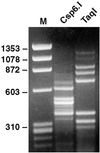A virus discovery method incorporating DNase treatment and its application to the identification of two bovine parvovirus species
- PMID: 11562506
- PMCID: PMC58777
- DOI: 10.1073/pnas.211424698
A virus discovery method incorporating DNase treatment and its application to the identification of two bovine parvovirus species
Abstract
Identification of previously unrecognized viral agents in serum or plasma samples is of great medical interest but remains a major challenge, primarily because of abundant host DNA. The current methods, library screening or representational difference analysis (RDA), are very laborious and require selected sample sets. We have developed a simple and reproducible method for discovering viruses in single serum samples that is based on DNase treatment of the serum followed by restriction enzyme digestion and sequence-independent single primer amplification (SISPA) of the fragments, and have evaluated its performance on known viruses. Both DNA viruses and RNA viruses at a concentration of approximately 10(6) genome equivalents per ml were reproducibly identified in 50 microl of serum. While evaluating the method, two previously unknown parvoviruses were discovered in the bovine sera used as diluent. The near complete genome sequence of each virus was determined; their classification as two species (provisionally named bovine parvoviruses 2 and 3) was confirmed by phylogenetic analysis. Both viruses were found to be frequent contaminants of commercial bovine serum. DNase treatment of serum samples may prove to be a very useful tool for virus discovery. The DNase-SISPA method is suitable for screening of a large number of samples and also enables rapid sequence determination of high-titer viruses.
Figures





References
-
- Choo Q L, Kuo G, Weiner A J, Overby L R, Bradley D W, Houghton M. Science. 1989;244:359–362. - PubMed
-
- Muerhoff A S, Leary T P, Desai S M, Mushahwar I K. J Med Virol. 1997;53:96–103. - PubMed
-
- Reyes G R, Kim J P. Mol Cell Probes. 1991;5:473–481. - PubMed
-
- Reyes G R, Purdy M A, Kim J P, Luk K C, Young L M, Fry K E, Bradley D W. Science. 1990;247:1335–1339. - PubMed
Publication types
MeSH terms
Substances
Associated data
- Actions
- Actions
Grants and funding
LinkOut - more resources
Full Text Sources
Other Literature Sources

